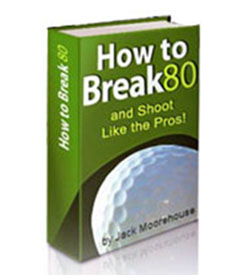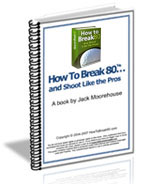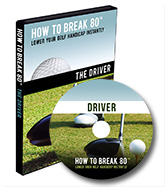|
Getting Hip To Hip Work
By Jack Moorehouse
As a teaching pro I see this swing fault all the time. I see it when giving golf lessons at the club, when practicing on the range, and when playing in a foursome. Bad players do it. Good players do it. Even the pros do it. What is it?
It’s poor hip rotation. This all too common fault haunts many players, causing a loss of power and a decrease in accuracy as well as an increase in a golf handicap. Everyone is susceptible to this fault, and it brings disastrous results with it.
Poor hip work is a big time problem. It shows itself as slices and pulls, so if you do either or both, it could be your hip work. But learning how to use your hips correctly in the downswing and practicing drills to improve your hip work helps you overcome this problem, leading to more power and increased accuracy
Three Components of Hip Work
The three components of proper hip work—a critical element of a good downswing—are weight shift, a slight lateral movement, and hip whip, the explosive rotation you get just before impact. To generate distance and lower your golf handicap, you must learn how to use your hips correctly.
Unfortunately, there are a lot of ways you can go wrong with your hips. The two most common are sliding laterally past the ball without enough rotation and spinning your hips too early without transferring your weight properly.
Committing these faults either separately or simultaneously throws off your hip work, and results in the slices and pulls you often see players hit, even low handicappers. Those shots can land you in big trouble on the course, which is why you want to avoid them at all costs.
Slide Then Rotate
In a good downswing, the hips slide then rotate. As you begin the downswing, you transfer your weight from the back hip to the front hip, setting it up as the rotational center for release. This can only happen if you retract your abdomen upward and outward, pushing your rear out. Your butt acts as a counterweight keeping everything in balance.
A simple test tells you if you have proper hip action. Take your normal set-up and then in slow motion pretend to take your swing, but pose at the impact position. Now, take a club and lay it across your hips. It should point at a 45-degree angle. This 45-degree angle is critical.
Unfortunately, many golfers don’t achieve the 45-degree angle required. Of the players taking golf lessons from me, only 20-25 percent achieves the right angle, which is why hip rotation is a key topic in my golf instruction sessions. Even good golfers are susceptible to this swing fault, so everyone needs to be wary of it.
Here’s a drill that will help you maintain proper hip rotation during your swing. Tee the ball and then assume a normal address position with two clubs in your hands—a 6-iron and a 7-iron. Next, lay the clubface of the 6-rion on the ground and the butt end against your back leg, inside your hip line. The head of the club rests on the ground just inside of your back foot.
Now hit a ball with the 7-iron. Keeping your right hip back as you start down. Since the hip is supposes to slide before it rotates, the club should lay propped up. If your hips open prematurely, the club will fall to the ground. It’s that simple.
Work on this drill until you feel you have the proper hip work ingrained in your swing. Keep working on it every chance you get. Once mastered, proper hip work will show itself at the range, while taking lessons, or on the course in more power, increased accuracy, and a lower golf handicap.
Jack
Moorehouse is the author of the best-selling book “How
To Break 80 And Shoot Like The Pros.” He is NOT a golf pro, rather a
working man that has helped thousands of golfers from all seven continents lower
their handicap immediately. He has a free weekly newsletter with the latest
golf tips, golf lessons and
golf instruction.
|
Tools To
Help Your Game!

eBook

Physical Book

Audio Program

Short Game DVD

Driver DVD
|